We’ve all heard the jokes and the ridicule. We’ve heard western pleasure horses called peanut rollers, zombies and creepers. It’s been claimed that time-elapsed photography is the best way to determine if they are actually moving around the arena, and that watching paint dry is more exciting than watching a western pleasure class. Because much of the criticism is justified, western pleasure has endured one of the longest running negative public images of any showing discipline.
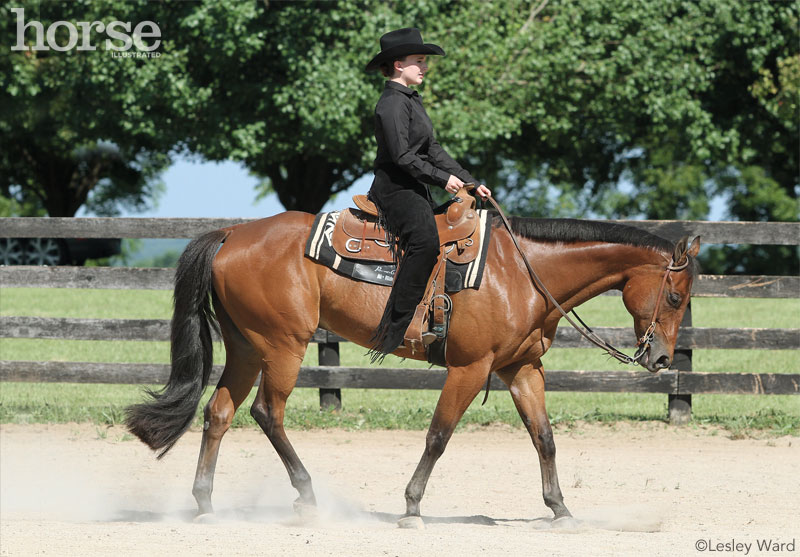
What, exactly, is the problem with western pleasure? Those within the discipline’s inner circle—trainers, exhibitors, breeders and the stock horse breed associations—know that how the class is judged has been a problem. The general horse-loving public, however, just sees horses moving painfully slow with their too-low heads flopping languidly about their knees.
The solution to the problem is obvious. Change the way the class is judged, and you change the class. And this is just what associations like the American Quarter Horse Association (AQHA), the American Paint Horse Association (APHA) and the National Snaffle Bit Association (NSBA) have done.
The Beginning of the Bad Rap
Former AQHA President Bill Englund, of Cashion, Ariz., has been judging American Paints and Quarter Horses for 35 years. He can date the origins of western pleasure’s problems back more than two decades.
“Back in the 1970s, the horses had a lot of natural movement,” Bill recalls. “Their gaits were true, they moved out faster, their heads were elevated about an inch or two above level, and they seemed brighter.”
According to Bill, the trouble began when trainers and exhibitors started slowing their horses down in order to win.
“By the 1980s we began to see the trend in which slower horses were winning, so everybody tried to get their horses to go slower,” Bill says. “And when they went slower, their heads started dropping, and their gaits became manufactured. The horses started going so slow that they couldn’t move properly.”
|
The trend didn’t happen suddenly. Rather, it became the fashion because of who was winning. If the best horse in the class just happened to be going slow, then everyone saw that and started slowing their horses down. They got slower and slower gradually. It’s similar to someone coming into the show-ring wearing a giant bow in her hair and winning the class because even though the judges hated the bow they thought she had the best horse. The other exhibitors see this and the next thing you know, everyone is wearing giant bows in their hair. Every time a judge pins a horse that is moving improperly, that judge is reinforcing the trend.
Prior to this period, judges considered conformation and condition for 20 percent of the horse’s overall score. This part of the class was eliminated for about 10 years, and western pleasure hit rock bottom when the horses began coming into the ring looking underweight and intimidated.
“[Trainers] were holding back horses’ feed so that they didn’t have the energy to go fast,” Bill says. They also left horses in their stalls with their heads tied up for extended periods of time, until they were too tired to hold them up on their own.
The AQHA made some initial efforts to counteract the trend, including reinstating the rule that condition and conformation be considered as part of a horse’s total score toward the end of the 1980s. The association also began hosting judging seminars to better educate judges about the western pleasure standards and to encourage more consistent judging. But by the early 1990s, the problem was still so bad that the association passed a rule that called for the disqualification of horses whose heads were too low.
“This didn’t really work,” Bill says. “Some judges disqualified horses; others didn’t, so it was inconsistent.”
Bill has been judging AQHA shows since 1971 and APHA shows since 1974. He also holds judging cards with the NSBA, the National Reining Horse Association and the Appaloosa Horse Club. He judges an average of 20 shows each year, has judged the AQHA World Championship Show five times, APHA’s World Championship Show 11 times and has judged western pleasure classes all over the world. He admits he sometimes finds it difficult to disqualify a horse.
“People have traveled a long way, they’ve paid their entry fees and they want to be judged,” he says. “So instead of disqualifying them, I wouldn’t place them, or I would knock them down to the bottom of the class.”
Just when it seemed like the class couldn’t have any more problems, it did. Despite the efforts of the associations, judging remained inconsistent with the standards of the class and the rules. Then, another new trend started catching on.
“Horses started traveling canted toward the rail,” Bill says. “In other words, with their heads toward the rail and their hips toward the center of the arena, so they weren’t moving down the rail straight. [Trainers] started doing this so that they could slow the horses down even more. This gives the appearance that the horse is reaching underneath itself further with its hind legs, so he looks like he moves better than he actually does.”
The Turning Point
In 1993, the AQHA initiated a new judge monitoring program. The program places field representatives at shows to watch how judges place the classes. The role of the field representative is to also help out at the show any way he or she can, including assisting the show manager, conducting registration inspections and answering questions exhibitors have regarding rules and the association. In 2005, the APHA started a similar program.
Three years ago, AQHA Executive Director of Judges Alex Ross, along with Dale Livingston, who teaches many of AQHA’s judging seminars, produced a video that exemplified in detail the ideal western pleasure horse. The AQHA’s five-member executive committee sent the video and a letter to every one of its judges.
“The purpose of the tape and the letter was to address how the executive committee wanted to see the class change for the better,” Alex says. “In it, the executive committee addressed a couple of points, particularly horses not displaying self-carriage and the lack of forward motion at both the jog and the lope.”
The letter stated, “Effective immediately, the lope described as slightly increasing forward motion would become the only gait recognized as a lope in AQHA-approved competition.” The letter also stated that it was mandatory, effective immediately, that the jog be extended in at least one direction, and described the extended jog as a definite two-beat lengthening of stride with an increase in pace. The letter and video drove the point home.
The Educated Judge
AQHA, APHA and NSBA currently hold regular judging seminars and academies for their judges. Trainers and exhibitors can also attend these seminars to get insight into the standards of the classes and how the associations want the horses to be judged.
“At the [AQHA] World Shows, the judges meet before every class,” Alex says. “We review tapes and discuss each class’s rules. The intention is to get the judges on track as far as following the rules and judging positively.” APHA judges follow a similar protocol.
The rules governing western pleasure classes for all three associations have evolved to the degree that they now state specifically how the class should be judged and what faults are to be penalized. In 2005, the APHA’s Show and Contest Committee appointed a task force to submit a revised rule that will give an even more specific description. If approved, the new rule will go into effect in 2007.
APHA Director of Shows Tina Anderson says that exhibitors will show their horses however the judges want them to. Alex Ross says the exhibitor attitude is, “Tell me how I’ll be judged, and I’ll tell you how I’ll perform.”
Western Pleasure Popularity
In terms of number of entries, western pleasure is the most popular class at both American Paint and Quarter Horse shows. The Quarter Horse Congress, held annually in Columbus, Ohio, is the world’s largest single-breed horse show. A total of 22 western pleasure classesare offered in Youth, Amateur, Novice, Open, Team Tournament, Futurity and Maturity divisions.
|
“Traditionally, the western pleasure classes have been the largest classes at the Congress for many years, with entries from more than 100 to 300 for nearly each division,” says Connie Lechleitner of the Ohio Quarter Horse Association, which puts on the show.
“Twenty-nine percent of all our show entries are in western pleasure and hunter under saddle,” Tina Anderson adds, noting that the APHA combines entry statistics of these two rail classes. “In the novice and open divisions, it is even higher.”
While serving as chairman of the judges committee for the AQHA in 2003, Alex Ross tracked the total number of entries in western pleasure classes at AQHA shows in five-year increments from 1985 to 2000. “The numbers were declining,” he says. “Then, last year, the numbers were up. I think that because of the rule changes and the way the horses are now being exhibited, the class is appealing to a greater number of people again. Judges have done an excellent job of changing the standards, and as a result the exhibitors are doing an excellent job of changing the way they show their horses.”
One of the reasons for the popularity of the western pleasure class is that it is a platform for all other western classes, such as western riding, horsemanship and trail. And, because of its popularity, it is considered very prestigious to win a world championship in the class.
“What happens at the World Shows sets the standards for the rest of the year,” Bill Englund says. “People see who wins the World Championship and then they try to emulate that horse. For this reason, it’s very important that the judges do a good job at the World Shows.”
New Standard Realized
In the 2-year-old western pleasure finals at the 2005 APHA World Championship Show, a horse came into the ring that Bill describes as the best western pleasure horse he’s ever judged. The horse was Docs Jet Settin Gal, a bay overo mare owned by Leonard Farms of Gibson City, Ill., and shown by her trainer, Wade Spell of St. Louis, Mo.
“She was a great horse,” Bill says. “She moved on the rail well, her gaits were good, and her ears were pricked. She looked like a pleasure to ride. I placed her first.” All five judges placed Docs Jet Settin Gal on their cards, and she easily won the World Championship.
Wade Spell, who has been showing and training Paints and Quarter Horses for about 20 years, says western pleasure is headed in the right direction. “For a while, the horses were really bobbing their heads, moving slowly and were [canted] to the inside,” Wade says. “Now, judges are looking for a lot of self-carriage—more of a natural show horse than a manufactured one.”
Wade says that this change in judging has changed the way he trains and shows his horses. “They want a natural-balanced horse, so it suits me better,” he says. “I was never into having them [canted] to the inside and moving real slow. This is helping me out a lot.”
For Wade and other trainers like him, the decisions the judges make in the show pen dictate how successful he will be in his profession. The same is true for breeders like Ann Myers of Ashland, Ohio, who owns AQHA world champion western pleasure horse Zips Chocolate Chip and specializes in breeding champion pleasure horses.
“Asking for the horses to move forward has allowed them to exhibit their natural movement better than they have in recent years,” Ann says. “The slowest horse is not always the best horse.”
This change enables the get of Zips Chocolate Chip, who has sired 30 world champions to date, to better showcase the movement they were bred for.
“A real western pleasure horse is good minded and wants to go slow on his own,” Ann says. “The great ones have both of these attributes combined with graceful, beautiful and effortless movements that everyone can recognize whether they know what they are looking at or not.”
Alex Ross says that anyone coming to watch the western pleasure class at one of the AQHA’s World Shows will see a really good group of horses. “The horses are fat and slick, and their expressions are good. There has been a dramatic difference in how horses are being presented by their trainers and exhibitors. How they are being shown now is much more positive. They have a lot of forward motion and self-carriage, and their toplines and expressions are better.”
“The industry has finally dictated that we want them moving forward and straight, looking bright and alert with their heads at least level,” Tina Anderson says. “I believe we are seeing horses moving in this manner today and winning.”
Further Reading
Video: AQHA Western Pleasure Judging
Guide to the Slow Jog
Western Pleasure Riding Topiclist
This article originally appeared in the June 2006 issue of Horse Illustrated. Click here to subscribe.

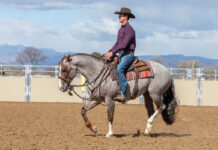
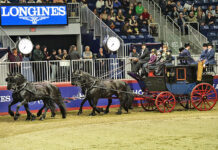
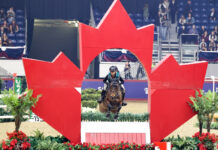
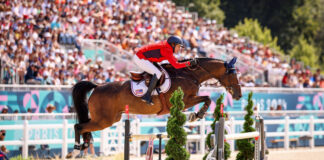

I loved this article! After 20-years of being out of the show ring I’m coming back. I am so happy to see the “slow mover” trend on it’s way out. I plan to allow my mare to move the same way my horses moved in the late 70’s. Naturally collected. I did very well then and I plan to do very well now. This is exciting!
The day we hire trained judges (not involved in the horse industry, except to be hired judges), not judges who are trainers or breeders or horse ranchers, is the day we will see the industry change, until then the western pleasure industry will continue on this downhill slide.
I am so glad this article was written. At local shows the same man wins on his 30 year old horse because it moves the slowest and has been around for the longest. I seen the horse out in the paddock one day running with a bunch of ponies and his natural gaits were gorgeous, it made me want to be sick that he was making his poor horse run like that. I’ve won many a western pleasure class and I have never altered the way my horse has carried her head.
That’s so good to hear!!
i am so glad that judges are getting the point that not all horses are perfect, horses are meant to MOVE they are pray animals. I do western pleasure and my horse is by far from the slowest horse but he looks a lot better going at a semi-fast speed then the robotic horses. when i get placed high i get the riders of the robotic horses looking at me like how did she get places she was too fast.
that just makes western pleasure look wrong.
The discipline you subscribe to matters not at all; what should matter to every horse breeder, trainer, owner is the correct conformation, health and movement of the animal. If your horse isn’t quite what you’d like it’s not the horse’s fault. It is cruel to artificially “correct” their conformation. Carefully, very carefully breed for the next generation. And take good care of the ones you have.
I had a really nice moving Appy filly that was made for western pleasure. She did not, however, drag her head in the dirt. I couldn’t get her placed in a class for the life of me. She was truly a pleasure to ride, responsive, gentle and sensible. I had to switch her to hunt seat to show her successfully. My hunt seat riding is pretty mediocre, so a friend rode her in a Class A show with 2 beginning hunt seat classes when one happened to come up nearby. She placed second in both, with one class having 73 mostly foreign bred warm blood circuit horses going to shows in Pa and NY later in the year. She beat the horse that beat her in the first class of 50 some odd in the second. I’ve never shown a horse in a class that big to have the judge screaming “Hey Appy!” as she went by before. There were Tbreds, Oldheimers, Trakheners and Hamburgs in the class, all towering over my little 15 hand Appy filly. I was so proud.
Western Pleasure is the best single event in the Equyestrian world. How many riders do you know that can lope or (canter slow for those non western term taught riders) and ride with little rein contact and the execute movements such as stop, slow speed, change direction and pivot and back without using their reins or much leg at all. Probably not a lot of non-western riders. No fuss riding with style and perfection. I love it
I consider myself someone in for the long haul. I went from someone not interested in the movement of bicycling front legs. After years away from the class time spent in the Dressage ring we began to discuss how the horses could move better. I am pleased see how the class continues to improve and training perserves not interferes with movement. Hats off to all of you who continue to make this very enjoyable class better and better.
This is a change that was long overdue. Now, if only it will finally filter down to the Ohio 4H judges, who are the ones that judge the large majority of open breed shows in Ohio. The days of this crippled look are finally appearing to be over. The sad thing is how it spilled over into the English disciplines as well, with some of the garbage that judges were pinning at the top of a class being absolutely absurd. I know that a Quarter Horse or Paint isn’t going to move like a Hanoverian or Trakehner, but an English horse should move like an English horse. For the longest time, judges were pinning these slow moving Western Pleasure horses high in English classes (aka Hunter Under Saddle), just because they moved the same way with English tack.
Alot of people are Saying that alot of judges are DQ people for horses that 4-beat, but the AQHA and them don’t?
I dont get that Please help and explain!!!
Thanks
wow!!!
I train kinda part-time in Boise,Idaho region and went to a show last year, 2009, for the first time in a long time. I was very disappointed in the pleasure and english classes and figured that showing is not where I wanted to be anymore. There was not a horse that could canter straight, but instead with the hip tilted in. The english riders had not even the slightest contact and hunched over the horses withers. The judge had judged paint regional and other high point shows and placed horses with the most un-natural canters that I could not wrap my mind around. I really appriciate this article and hope that these changes will occur in the show circuits and I will continue to show the way I learned some 20 years ago. I may not place as well but my horses are happy and consistant. Thank you for your time.
I know this guy named Dwain Junker, he owns Junker Training in Fairbury, Nebraska. He trained my friends horse and on that horses first show it got third!!! I was amazed! he is an excelent horse trainer!! I would recommend him to anyone!! I hate getting
DQs for 4-beat! It happened to me once and i flipped out! I wasn’t even up to a lope yet!! and they dq-d me!!
I have been to a few two day AQHA shows in the last two months and I was very disappointed in the quality of the Western Pleasure classes. In the youth classes the horses move like they are supposed too butter when the Amateur riders come in it looks terrible. Hips into the inside and even back feet knocking together. How can anyone think that this looks good? There was one woman and her horse that were wonderful. They moved correctly and with forward motion. They didn’t place. I love showing Quarter Horses but I am very discouraged in how these judges keep placing these riders who are awful. Just because they are afraid of some ruffled feathers. More people need to start speaking up and making these changes happen.
who ever says western pleasure is boring, stupid or lame is boring, stupid or lame. i think it is the best show ever!!! that coming from a 12 year old. my horse and me have never been a western pleasure show but that is our dream. and no one can crush that.
I watched a video of last year’s world champion. The horse’s rear foot never left the ground during the lope. It dragged it like it was completely lame. And nearly every local show I have been to, the winner looks like it was purposely lamed. Honestly this is animal abuse. They had better get the standards changed. It’s way over due.
I wish they would stop the vague ‘at least level’ definition for headset! I won’t ride a horse who keeps its head/bit lower than its withers…just too dangerous!! As for changes, I have yet to see them here in Canada!! Same people winning the same pleasure classes, you know the ones, jabbing their horses in the mouth every time they are behind the judge!! Their horse’s heads are way below the withers and even tucked behind the vertical as well and they are winning! Ya right big changes!!
i ride [leasure and my horses headset does not go below its withers i wont let it. when i go to local shows there is always this one horse who i think is purposely lame!!! he just drags along and always wins
Wish your article and associated rules would reach Oklahoma. It sure has not caught on here. It is pitiful! The western pleasure in all the breeds that I have seen is still back in the dark ages of “barely forward motion”! No one here knows how to lope with forward motion! If all of us who think this change is way over due start doing and something about it and showing our horses the way we talk about, the judges would have to start judging correctly and not pinning half lame gaited horses!!!!!!!!!!!!!!!!!!!!
I hope this goes into effect immediately. I ride English pleasure at local shows and the same horses have been pinning in our class too. “Peanut rollers.” It’s not a natural way to move and I’ve seen riders hitting their horses in the mouth to achieve this headset.
There is an awesome video on Youtube that shows this (AQHA Western Pleasure) I plan on showing my horse in western pleasure and win or lose he will move out and we may pass others but hopefully the judge will take note of a horse that looks like a pleasure to ride and we can help change the view of Pleasure classes!
There definately needs to be a change in the way the class is judged! even in the lower level shows! I know in my area that they are judged incorrectly- for a fact.
Sun circuit Scottsdale, my daughter cried and my son walked away. The peanut pushers are grotesque!!!! Not one western pleasure horse had its head level. Aqha is a joke and powerless. Someone please save these tortured animals!!!
This is a great article! I have been showing WP for a couple years and am just now starting to see this change. It’s really helping me, too because I have never been able to get the horses really slow and heads completely level.
Wow Horse Channel, great article!
I truly hope they change the judging of these horses. I own and ride a western quarter horse, but I wouldn’t want another one and I won’t go to any stock horse shows after seeing the little crippled pleasure horses. If they don’t hurry up and change they’ll drive people to other breeds that are shown naturally.
Its about time … no more watching sad horses and waiting for them to fall like dominoes if one stops suddenly or a gust of wind comes along.. Western Pleasure may now be a pleasure again for horses, riders and spectators.
It’s been 12 years since this article was written. Has anything really changed?
I’am reading this in 2019 and still see the same sorry looking pleasure horses,